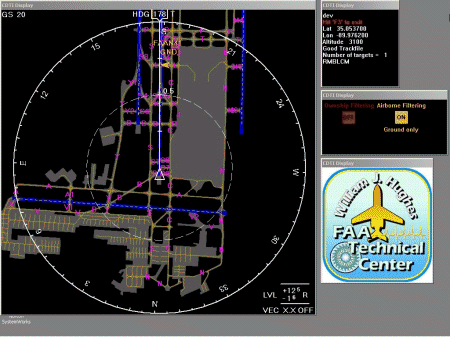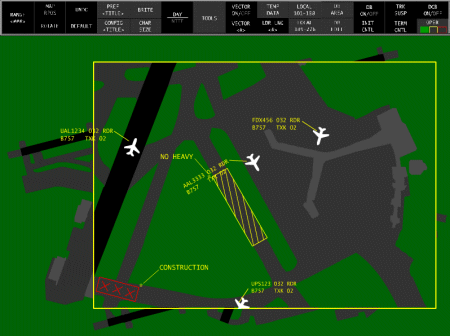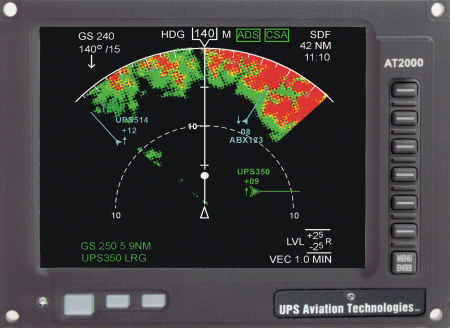US industry and government have been working on technologies to improve flight safety for three years. The result is Safe Flight 21
RAMON LOPEZ / MEMPHIS
A one-day forum held in Memphis, Tennessee, has showcased progress of a three-year collaboration between government and industry to test emerging technologies designed to improve flight safety while increasing capacity.
The event, which took place on 13 June, was spearheaded by the US Federal Aviation Administration, FedEx Express and the Cargo Airline Association (CAA).
The backbone of the Safe Flight 21programme is automatic dependent surveillance-broadcast (ADS-B) and traffic information services-broadcast (TIS-B). They are designed to demonstrate nine "free flight" operational enhancements such as supply of weather data in the cockpit and better terminal operations in low visibility.
The ADS-B equipment relies on the global positioning system (GPS) to "display" targets. An ADS-B-equipped aircraft uses a digital datalink to broadcast its position. It can be used by pilots to avoid conflict with other aircraft in the air or on the ground. The system gives an aural and visual alert if it identifies a potential conflict with other aircraft equipped with the system. It can give controllers an aircraft's position, speed, altitude and direction data without radar.
ADS-B will enable pilots and air traffic controllers to share the same information. Aircraft and ground vehicles on the runway will be able to broadcast and receive messages such as aircraft or vehicle identification, position, velocity and direction.
The near-real-time information will be displayed to pilots on a cockpit display of traffic information (CDTI), giving the location of other ADS-B-equipped aircraft.
A consolidated picture of controlled airspace will be available to controllers through ADS-B, while TIS-B will provide the means for air and ground vehicles to broadcast and receive ADS-B messages via a digital datalink.
Filtered traffic and other data, now only accessible to controllers on the ground, will be made available to cockpits.

Digital dimension
Safe Flight 21 is also geared towards collecting data on the performance of three candidate digital datalinks: Mode S, the Mitre-developed universal access transceiver (UAT) and VDL Mode 4. One of the objectives of Safe Flight 21 is to select a datalink standard for ADS-B by the end of next year.
ADS-B pioneer UPS Aviation Technologies (UPSAT) has received Supplemental Type Certificates (STCs) from the FAA to install ADS-B on United Parcel Service (UPS) Boeing 727s and 757s. UPS is seeking STCs for its Boeing 747s and 767s, McDonnell Douglas DC-8s and Airbus A300s. More than 230 UPS freighters are due to have ADS-B by the end of the year.
The UPSAT ADS-B system incorporates a Link and Display Processing Unit containing the system's computer hardware, datalink equipment and a dedicated GPS receiver. It communicates digital position messages and other information to an advanced Mode S transponder for broadcast as an extended digital message.
Compatibility
It works with both Mode S and the UAT datalink, allowing the operator to use the two datalinks independently or in tandem.
A live operational demonstration of cockpit surface moving map technology on a CDTI depicted the FAA's 727 research aircraft's own position on the runway and that of other ADS-B-equipped aircraft and airport vehicles. The targets overlaid the Memphis airport surface moving map, showing traffic information that a pilot would see in the cockpit. "This is not rocket science," says Paul Fontaine, Safe Flight 21's product lead. "You can get the same thing in a rental car. But the difference is that you need 100% accurate data in the cockpit."

Safe Flight 21 involves development and production of both general aviation and air transport category moving maps. For general aviation, the use of ADS-Bs near mountains and in areas with limited or no radar coverage is the focus of Safe Flight 21's Capstone initiative in Alaska (Flight International, 24-30 October 2000). Use of ADS-B to track air traffic began on1 January in the Bethel area of western Alaska, and the FAA is extending the initiative to south eastern Alaska (location of state capital Juneau) before making these changes statewide. A contract covering 200 additional general aviation aircraft shipsets with surface-moving-map (SMM) functionality will be awarded in December.
Meanwhile, Honeywell, L-3 Communications, Rockwell Collins and UPSAT are seeking to implement SMM and approach-spacing functionality on a set of ADS-B avionics for transport category aircraft as part of the test and evaluation surveillance information system effort. A contract is due to be awarded in August.
Within two to three years, the FAA expects to see a basic SMM that determines an aircraft's position on a runway or taxiway.
UPS Aviation Technologies has developed a prototype moving map of the airport surface that combines conventional GPS and ADS-B technologies to give pilots a clear view of their aircraft's position relative to airport runways, taxiways and other traffic. It plans to certify the airport SMM by the end of this year.
SMMs may also be displayed on a so-called electronic flight bag or portable side display, which would contain approach charts, airway and flight operations manuals. The FAA and UPSAT demonstrated a prototype aboard the FAA's 727 research aircraft. An advisory circular regarding the electronic flight bag is expected to be released soon.
Enhanced SMMs
The next step is a surface moving map which adds ADS-B or TIS-B data, allowing pilots to see surrounding targets. In the future, occupied runways would turn red. Meanwhile, NASA is working on a runway incursion prevention system (RIPS) that combines a head-down moving map display of taxiways and runways with guidance on a head-up display. RIPS generates visual and aural warnings for pilots and controllers when another aircraft or vehicle is about to encroach on the runway or taxiway. RIPS also uses specially-developed computer software, GPS technologies and ground technologies developed by the FAA's runway incursion reduction programme (RIRP).
Also crucial is further development of control-tower surface-situation display capabilities. Northrop Grumman airport surface detection equipment model 3 (ASDE-3) surface monitoring radars have been installed at 34 major US airports, enhancing tower controllers' ability to monitor ground movement when visibility is low due to rain, fog or night operations.
The 34 airports that will ultimately have ASDE-3 will also receive the airport movement area safety system (AMASS) software upgrade, the first of which was installed this month at San Francisco International. By using data from ASDE-3 and other sources, AMASS - a collision avoidance device - determines potential conflicts based on aircraft position, velocity and acceleration, as well as that of vehicles in aircraft movement areas.

In October last year, ASDE-X prime contractor Sensis received $100 million from the FAA to develop a lower-cost modular alternative to the ASDE-3. A prototype for the ASDE-X surface movement radar system, designed for second-tier airports which will not receive ASDE-3 and AMASS, will undergo operational evaluation later this year.
The system, which incorporates multi-lateration and ADS-B, will be appraised at Memphis International Airport, which has multi-lateration ground stations installed. Sensis, teamed with Raytheon, will provide ASDE-X units at a minimum of 25 US airports.
The core ASDE-X system consists of a Raytheon high-resolution ground surveillance primary X-band radar, multi-lateration sensors capable of receiving ADS-B, a multiprocessor and multiple displays. The fusion processor integrates data from the radar and multi-lateration devices to provide controllers with target identification.
Immune to false targets
Multi-lateration sensors work with Mode S transponder-equipped aircraft and ground vehicles. The ASDE-X system depicts aircraft vehicle position and identification information overlaid on a colour map showing the surface movement area and arrival corridors.
FAA officials say it is immune to multipath false-target problems and heavy rain, and can integrate various inputs for optimal aircraft position estimates. The design allows for future enhancements, such as cockpit datalink via TIS-B. The FAA has designated Orlando International as the first operational ASDE-X airport, with the unit going into service in April 2003. The contract allows for procurement of up to 66 systems.
ASDE-X involves three overlapping phases. The initial phase ends with deployment of initial basic ASDE-X surface surveillance systems. Phase 2, which began this year and runs to 2004, will determine how many more airports get the safety device. An ongoing investment analysis is due for completion in September.

The second phase will also determine how ASDE-X elements, such as the fusion processor or multi-lateration sensors, might work with ASDE-3/AMASS. The third and final phase, which extends the programme another year, would tag all aircraft on the runway surface, not just ADS-B-equipped vehicles. It would also allow for broadcast service uplink to the cockpit, using UAT ADS-B link integration. Fontaine says the US aviation agency is exploring whether multi-lateration can be extended into terminal airspace.
Safe Flight 21 involves a series of operational evaluations (OpEvals) on aspects of ADS-B, two having taken place in July 1999 and October 2000. OpEval-3 will involve airport situational awareness and runway incursion alerting.
More OpEvals are planned for Memphis. They are designed to develop and evaluate the avionics and procedures needed to enhance surface surveillance with ADS-B.
Source: Flight International
















